We know our cities are a honeypot for young people, with jobs, entertainment.. and other young people. But when they hit the age at which their parents moved out to the ‘burbs, has the current generation of youth remained in our cities long after that demographic title had expired? Glenn explains how much of this story we can confidently tell using Australian Census data.
Recently we had a question from a reader at the City of Adelaide (ok – we got the question in June – sorry Penny!), who had read about a worldwide trend for young people to move to – and stay in – large cities.
Penny wanted to know whether this was happening in Australia as well. The article refers to a long term trend that pointed to young people staying in inner cities longer.
I guess there are two possible outcomes here – in the first, young people move into cities at the age of 20 or so, attend university, live the high life with entertainment and employment opportunities on-tap, but by their late 20s, they move out to suburban and regional locations, settle down and have families. We know that young people do that.
But the article does also refer to young people staying on in inner-city areas much longer, at an age where they would’ve previously moved out, they are sticking around. Is this happening in Australia?
The need for longitudinal data
Anecdotally, there is some indication this is happening, but there is definitely still movement outwards as people reach family formation age.
To do this properly, we would need a longitudinal study (which tracks data for the same individuals over time). We don’t really have this data from the Census in Australia (there is a 5% sample but it only links the last 2 Censuses), so we can’t entirely answer this question.
Our youthful cities
So while the longitudinal dataset isn’t available, we can certainly look at the changing age structures of our inner cities using the cohorts surveyed in recent Censuses.
To put that another way, the people who were aged 20-24 and living in a city in 2011 may not be the same people who were aged 25 to 29 and living in a city in 2016 – to know that we’d need the longitudinal study). However, there is no doubt that our cities are ‘young’ places. But is that changing?
Since the query came from Adelaide, let’s look at the City of Churches (also one of the least religious places in Australia) as an example.
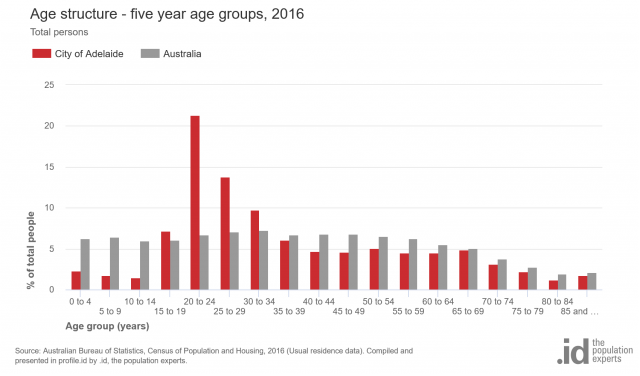
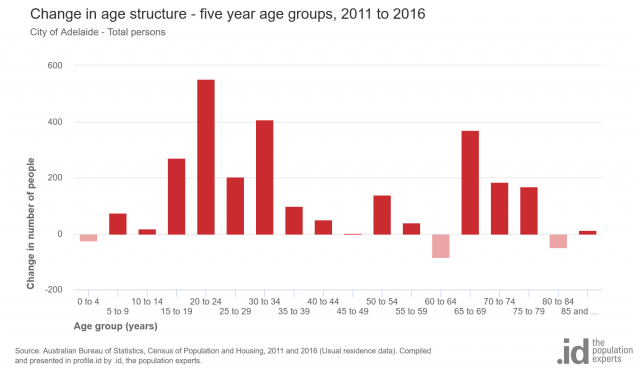
We can see that the bulk of the population is aged between 20 and 29. In fact, over one-third of the population of the City of Adelaide, which covers Adelaide and North Adelaide only (no suburban areas) are in this 10-year cohort.
Looking at the change in age structure, we can see huge growth in 20-24 year olds, more subdued in 25-29 and large again in 30-34. But there is also growth in those aged 65+. These are the key age groups attracted to higher density housing, and the City of Adelaide, as with all our inner cities, has been growing this type of housing at a rapid rate.
The growth of 30-34 year olds indicates that some people may be staying on longer in Adelaide, into age groups where they may have moved out to buy a house before. But it’s not conclusive – and looking at the migration table (which shows only those who moved, not those who stayed put and aged in place) still shows a net loss to other areas of the key 25-34 age group. So many are still moving out.
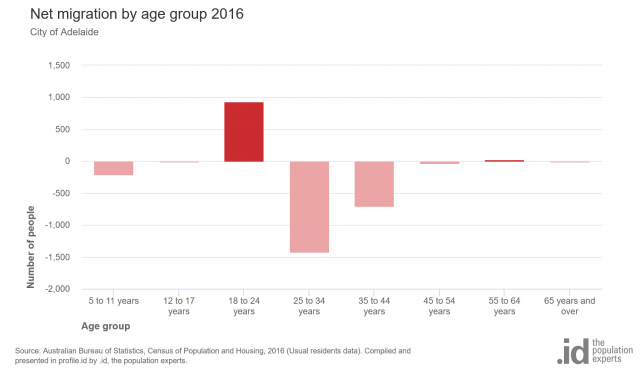
This migration chart is strongly negative in the 25-34 range. How can this be, when the age cohorts are growing in the charts above? Well, this only tells part of the story – internal migration. There are two other components of growth – natural increase is one – this is where you will see young people sticking around having migrated in when they were 18-24 and now in the next age cohort. This is some evidence that young people are staying in Adelaide longer. The other one is overseas migration – and Adelaide had over 5,600 people who were recent arrivals, arriving from overseas in the past 5 years, 56% of all their overseas-born population had been in Australia less than 5 years.
This is also typical of our inner city areas. So based on this, we can say that tentatively – yes, there is a trend towards young people staying in inner city areas a bit longer. There is still migration out, but it is countered by the large migration in among overseas-born in these age groups as well.
Where are young people coming from/going to?
The spatial patterns of migration tell an even more in-depth story.
The ‘Net migration by age and location’ page on our community profiles allows you to see which local government areas certain age groups have moved from and to between the last two Censuses. Looking at net migration between 2011 and 2016, for people aged 25-34 years, by location, you can see a strong influx from outer regions such as Adelaide Hills, Mitcham and Tea Tree Gully.
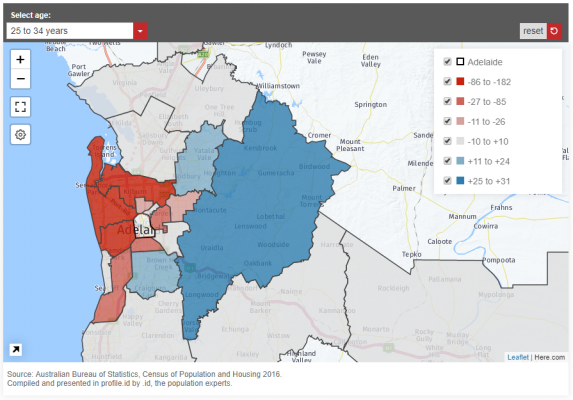
However, with the next age cohort (35-44), you see a very different story, with all migration being ‘out’ of the Adelaide City local government area to surrounding districts.
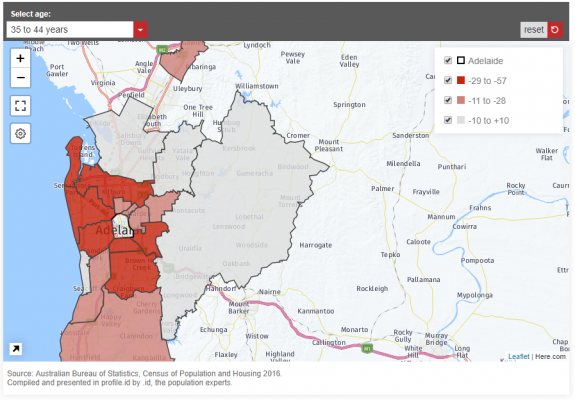
Where are the kids?
The other thing you’ll see is that there are relatively few children in inner cities. There are quite a few 0-4-year-olds, but very few school-age children. Generally, people with school-aged children or more than one child leave the city for larger housing elsewhere.
Check out these age charts for Sydney and Perth – it’s generally true that our cities are places for the young.
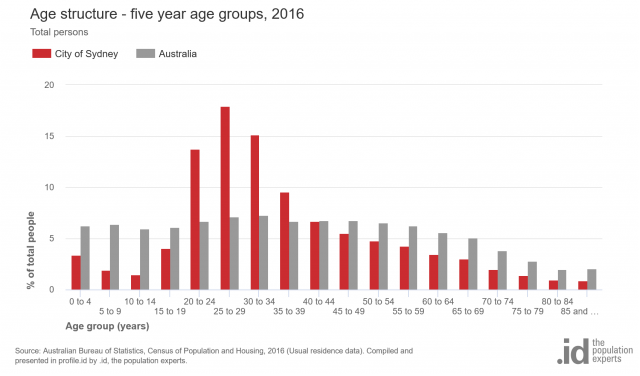
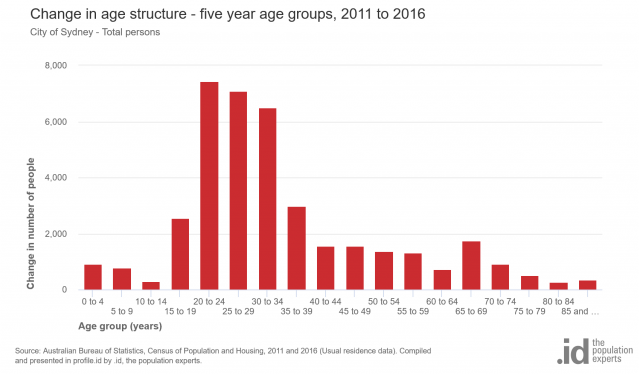
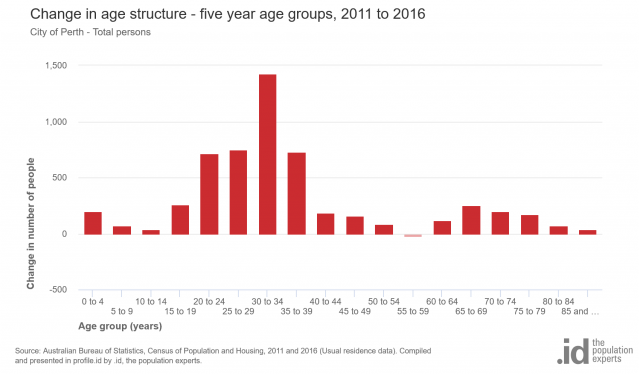

Interestingly, neither Sydney or Perth have the large increase in over 65s in the inner city either – they remain very young places. Downsizing into the city on retirement is a relatively small phenomenon, but does seem to be occurring in Adelaide.
Dig deeper into the demographics of young people
If you would like to understand more about your area’s young population (18-24, 25-34 or other age-based cohorts) or people who moved from overseas in the past 5 years, check out our “Communities of Interest” modules, which are available in some community profiles (depending on the subscription level in that area). These give you all the characteristics of specific population sub-groups, compared to the same group elsewhere, the wider population, and how they are changing.

















